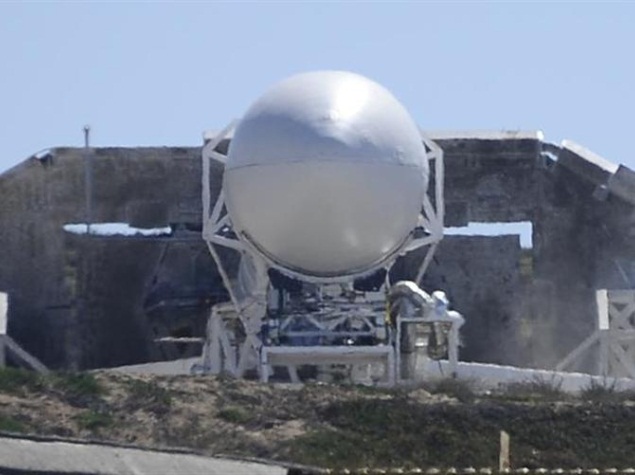- Home
- Science
- Science News
- SpaceX Dragon Capsule Returns From International Space Station
SpaceX Dragon Capsule Returns From International Space Station

The Dragon capsule departed the International Space Station at 2:10 p.m. EST/1910 GMT and splashed down about 260 miles (418 km) southwest of Long Beach, California, about 5.5 hours later.
The Dragon is loaded with nearly 4,000 pounds (1,814 kg) of returning science experiments and equipment, including two faulty components from spacesuits that Nasa wants to analyze before clearing astronauts for a trio of spacewalks later this month.
Dragon's return overlapped with the company's Falcon 9 launch attempt at Cape Canaveral Air Force Station in Florida. The rocket was grounded by high upper-level winds.
"Extreme wind shear over Cape Canaveral. Feels like a sledgehammer when supersonic in the vertical," SpaceX founder and Chief Executive Elon Musk posted on Twitter.
Extreme wind shear over Cape Canaveral. Feels like a sledgehammer when supersonic in the vertical. Hoping it changes ...
-- Elon Musk (@elonmusk) February 10, 2015SpaceX will try again at 6:03 p.m. EST/2303 GMT on Wednesday to launch the U.S. government's Deep Space Climate Observatory, or DSCOVR. The satellite is designed to serve as weather buoy to provide about an hour's advance notice of potentially dangerous solar storms, which can disrupt radio communications, satellite signals and power grids on Earth.
It also will monitor the sun-lit side of Earth, tracking volcanic plumes, measuring ozone and monitoring droughts, flooding and fires.
The launch of DSCOVR was planned for Sunday, but was delayed due to a problem with an Air Force radar system needed to track the Falcon rocket during flight.
Once the satellite is on its way to orbit, eventually reaching 930,000 miles (1.5 million km) from Earth, SpaceX plans to attempt to land the Falcon launcher's spent first stage, part of ongoing efforts to develop reusable rockets, potentially slashing launch costs.
The booster is programmed to separate itself three minutes after liftoff, turn around, make two braking burns and touch down on a platform floating about 370 miles (595 km) northeast of the launch site.
The last Falcon rocket to fly nearly made it back intact, but it ran short of hydraulic fluid to maneuver steering fins and it crashed into the platform.
For the second attempt, engineers added an extra reservoir of hydraulic fluid, but the rocket will be coming in with nearly twice the force and four times the heat, SpaceX said.
"Rocket re-entry will be much tougher this time around due to deep space mission," Musk wrote on Twitter.
© Thomson Reuters 2015
Catch the latest from the Consumer Electronics Show on Gadgets 360, at our CES 2026 hub.
Related Stories
- Samsung Galaxy Unpacked 2025
- ChatGPT
- Redmi Note 14 Pro+
- iPhone 16
- Apple Vision Pro
- Oneplus 12
- OnePlus Nord CE 3 Lite 5G
- iPhone 13
- Xiaomi 14 Pro
- Oppo Find N3
- Tecno Spark Go (2023)
- Realme V30
- Best Phones Under 25000
- Samsung Galaxy S24 Series
- Cryptocurrency
- iQoo 12
- Samsung Galaxy S24 Ultra
- Giottus
- Samsung Galaxy Z Flip 5
- Apple 'Scary Fast'
- Housefull 5
- GoPro Hero 12 Black Review
- Invincible Season 2
- JioGlass
- HD Ready TV
- Laptop Under 50000
- Smartwatch Under 10000
- Latest Mobile Phones
- Compare Phones
- OPPO Reno 15 Pro Max
- Honor Win RT
- Honor Win
- Xiaomi 17 Ultra Leica Edition
- Xiaomi 17 Ultra
- Huawei Nova 15
- Huawei Nova 15 Pro
- Huawei Nova 15 Ultra
- Asus ProArt P16
- MacBook Pro 14-inch (M5, 2025)
- OPPO Pad Air 5
- Huawei MatePad 11.5 (2026)
- Xiaomi Watch 5
- Huawei Watch 10th Anniversary Edition
- Acerpure Nitro Z Series 100-inch QLED TV
- Samsung 43 Inch LED Ultra HD (4K) Smart TV (UA43UE81AFULXL)
- Asus ROG Ally
- Nintendo Switch Lite
- Haier 1.6 Ton 5 Star Inverter Split AC (HSU19G-MZAID5BN-INV)
- Haier 1.6 Ton 5 Star Inverter Split AC (HSU19G-MZAIM5BN-INV)
-
 Prayagraj Ki Love Story Set to Stream Soon on Hungama OTT
Prayagraj Ki Love Story Set to Stream Soon on Hungama OTT
-
 Mask OTT Release Date: When and Where to Watch This Action-Packed Thriller Online?
Mask OTT Release Date: When and Where to Watch This Action-Packed Thriller Online?
-
 New Year 2026 Custom Greetings: 5 Best AI Prompts for ChatGPT, Gemini, and Other AI Tools
New Year 2026 Custom Greetings: 5 Best AI Prompts for ChatGPT, Gemini, and Other AI Tools
-
 NASA’s Chandra Spots Champagne Cluster Formed by a Massive Galaxy Collision
NASA’s Chandra Spots Champagne Cluster Formed by a Massive Galaxy Collision












